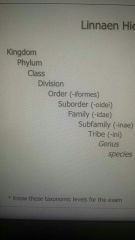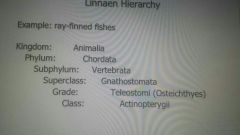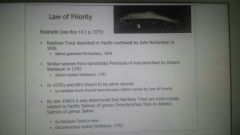![]()
![]()
![]()
Use LEFT and RIGHT arrow keys to navigate between flashcards;
Use UP and DOWN arrow keys to flip the card;
H to show hint;
A reads text to speech;
31 Cards in this Set
- Front
- Back
- 3rd side (hint)
|
taxonomy
|
science of describing and classifying organisms
|
|
|
|
systematics
|
study of evolutionary relationships of organisms
|
|
|
|
carolus linnaeus
|
father of taxonomy
systema naturae 1758 |
|
|
|
binomial system of nomenclature
|
genus species
latin names standardized worldwide international commission on zoological nomenclature |
|
|
|
linnaen hierarchy
|

|
|
|
|
linnaen hierarchy to know for exam
|

|
|
|
|
hierarchy ray-finned fishes
|

|
|
|
|
when writing names
|
italicize generic and species
capitalize generic higher units capitalized name of family in english lowercase common names capitalized |
|
|
|
name and date after species name mean
|
person first described and year they did
|
|
|
|
law of priority
|
oldest species name after 1758 has priority
|

|
|
|
morphometric measurements
|
measurable structures:
standard length fin lengths head lengths eye diameter ratios between measurements *but problem with allometry |
|
|
|
problem with allometry
|
lengths of different body parts change at different rates during growth
|
|
|
|
meristic traits
|
any countable structure:
# fin rays, vertebrae, scales, gill rakers, cephalic pores *may be most useful for comparison |
|
|
|
anatomical characters
|
characters of:
skeleton, soft anatomy, shape, latline position, sex *often 'present' or 'not present' |
|
|
|
color patterns
|
variable
subjective fades in preservatives have to use fairly permanent patterns like dark spots and stripes |
|
|
|
biochemical and molecular characters
|
protein electrophoresis
chromosome #s dna analyses |
|
|
|
taxonomic methods
|
morphometric measurements
meristic traits anatomical characters color patterns biochemical and molecular characters |
|
|
|
species and subspecies based on ___
|
type specimens
|
|
|
|
type specimens
|
used by author to describe new taxa
placed in permanent archival collections |
|
|
|
holotype
|
a single specimen designated as "the type" upon which description of new species was based
|
|
|
|
paratypes
|
additional specimens used in description of new species
|
|
|
|
whats a species
|
fundamental unit of classification
"biological species concept" "morphospecies concept" "phylogenetic species concept" |
|
|
|
morphospecies concept
|
defined by groups of morphological characters
somewhat subjective does not depend on evolution |
|
|
|
biological species concept
|
ernst mayr 1942
"groups of actually or potentially interbreeding populations which are reproductively isolated from other such groups" a species is an isolated gene pool |
|
|
|
phylogenetic (evolutionary) species concept
|
"a single linage of ancestor-descendant populations which maintains its identity from other such lineages and which has its own evolutionary tendencies and historical fate" (wiley, 1981)
better fit to current concepts of evolution |
|
|
|
cladistics/phylogenic systematics
|
willi hennig 1950
method of grouping organisms based on shared, derived characters-synapomorphies creates branching tree diagram-cladogram or phylogeny |
|
|
|
synapomorphies
|
characters more recently evolved, derived, or advanced
shared by descent, not convergent define monophyletic groups or clades |
|
|
|
symplesiomorphies
|
shared primative (ancestral) characters
not useful for determining relationships because may be retained by wide variety of taxa |
|
|
|
cladogram/phylogeny
|
branching tree diagram
|
|
|
|
monophyletic groups/clades
|
defined by synapomorphies
groups containing an ancestor and all its descendent taxa |
|
|
|
paraphyletic groups
|
groups that dont include all descendents of common ancestor
ex: fishes class:pisces excludes some descendents of common vertebrate ancestors like tetrapods |
|

